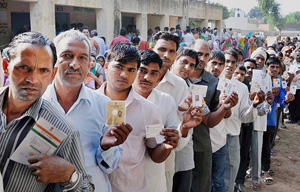Chandigarh, Oct 15: Haryana was heading towards registering an all-time record high turnout, with over 72 per cent voters having cast their votes shortly before close of polling at 6 PM.
In 1967, maximum polling of 72.65 per cent had taken place while in 1968 minimum polling of 57.26 per cent was registered.
In 2009 polls, 72.37 per cent polling was recorded.
According to tentative figures available with the Election Department, over 72 per cent of the 1.63 crore voters had cast their vote so far.
"More than 72 per cent voters had cast their votes when the polls were drawing to close. However, the final percentage figure was likely to go up as voters were still inside polling stations and all figures were being compiled," Haryana's Chief Electoral Officer, Shrikant Walgad told media person.
The Election Department officials said that those voters who had entered the polling station by 6 PM will also be allowed to cast their vote.
Close to 6 PM, places including Fatehabad district (78 per cent), Hisar (73 per cent), Jind (75 pc), Kaithal (79 pc), Kurukshetra (78 pc), Mewat (76 pc), Rohtak (70 pc) and Yamunanagar (79 pc) had witnessed healthy voter turnout.
However, at places including Faridabad district (57 per cent), Gurgaon (64 per cent) and Panchkula (66 per cent), the polling was not that high.
Amid tight security, polling commenced in all the 90 assembly seats at 7 AM to decide the fate of 1,351 candidates. Counting of votes will take place on October 19.
Over 1.63 crore voters including over 87 lakh women were eligible to cast their vote in the polls, in which stakes are high for ruling Congress, BJP and INLD.
Similarly, in Vidhan Sabha Elections 1972 in Haryana total percentage of polling was 70.46 per cent.
In 1977 the total polling percentage was 64.6 per, 69.87 in 1982, in 1987 total polling percentage was 71.24 per cent, in 1991, it was 65.86 per cent, 70.54 per cent in 1996, 69.01 per cent in 2000 and 71.96 per cent in 2005.
In the 2014 Lok Sabha polls, the voter turnout for all the 10 Lok Sabha seats in Haryana, where elections were held in April, was registered at 71.86 per cent.





Comments
Add new comment